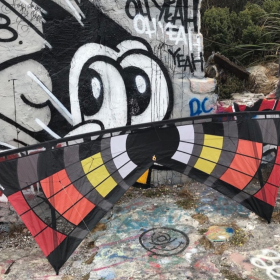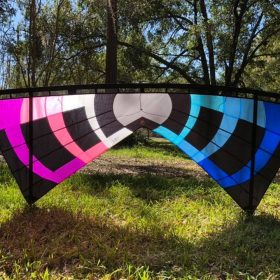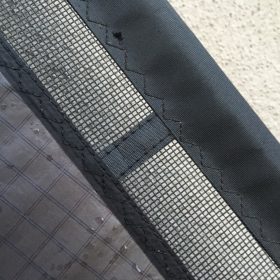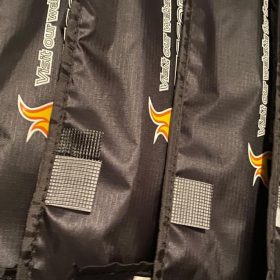Another Djinn article that is no longer available due to the publication closing its doors, Addict Kite published this in November of 2019, a very thorough exchange regarding the thoughts and passion that went into the Djinn.
John Barresi nous presente en exclusivite son Djinn
.
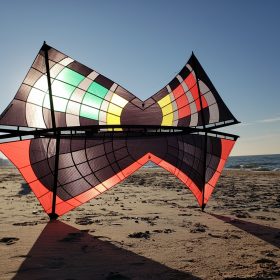
What can you tell about It? (the history, the development, the work you put into it)
Oh, it’s been a very exciting project… I think its best to start with a little history.
I’ve been a sponsored quad line performer and competitor since late 1991, gathering 17 US quad tales (out of 31 total) and I led iQuad on one of the most prolific tours in history between 2006 and 2013 when that team disbanded (nearly 125 team events attended In that time). During my entire career I have had the strange pleasure of flying in some of the most unusual and challenging environments In the world. as well as sharing a lot of field time with some of the best pilots in the world over nearly 30 years now.
In 2008 I became involved in the B-Series (Barresi Signature Series) kite project with Revolution by adding a few small adjustments to my taste (paneling and leading edge curve), In 2009 the B-Series PRO came into being thanks to the craftsmanship of Bazzer Poulter, using better materials and significant durability improvements over the factory edition – both models of B-Series quickly became some of the most popular kites in the world and are still very common to see although they are no longer produced.
During all of that time we were pushing our kites harder than ever before, more flight hours, more torque, more abuse, gaining more flight skill all the time, so it was really a golden opportunity for me and my co-pilots to find all the things that could make an even better kite for what I do… Parting ways with Revolution In 2016 due to creative differences, I began bringing all of my ideas together for a new quad and at the same time, my friendship with Brett Marchel continued to grow so we started design work together (he is also Addict Kite 2018 male pilot of the year and a member of Team KiteLife).
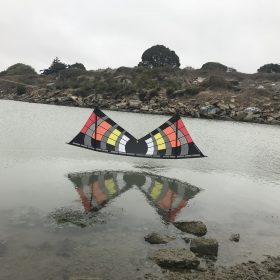 For nearly 2 years we experimented with shapes, design details, bridles and everything else we could think of until the first true Djinn prototype was ready for testing one year ago, more adjustments. then some factory samples, and finally we had our first factory sample produced in May of 2018… During this time I also released my first solo kite (Kaiju indoor dual line) under my own, new brand called Kite Forge.
For nearly 2 years we experimented with shapes, design details, bridles and everything else we could think of until the first true Djinn prototype was ready for testing one year ago, more adjustments. then some factory samples, and finally we had our first factory sample produced in May of 2018… During this time I also released my first solo kite (Kaiju indoor dual line) under my own, new brand called Kite Forge.
There is a full list of the kite’s features on the product page at Kite Forge, but I can tell you we have put loving eyes and hands on every aspect of the Djinn Including bridle, panel arrangement, reinforcements, special parts, etc. it was a very thorough project and most importantly, one that we refused to compromise.
The Djinn is made for ME, it’s designed for fliers like me In terms of performance. durability, assembly and replacement parts – its not a toy, it was created to equip me and my trained pilots with exactly what we need for top performance… Kiting Is not my hobby, it is the majority of my waking world and has consumed almost all of my passion since 2005, It is my life every day.
The vast majority of the Djinn concept / design work (flight experience) came from my mind but I would not have been able to give It life without Brett’s assistance on the building and some of the design details… It’s really our baby, together.
Full Djinn specifications…
My full kiting history can be found here…
http://johnbarresi.com/biography/
Our team website…
What are the advantages for kite and pilot) and extras you get with the special shape?
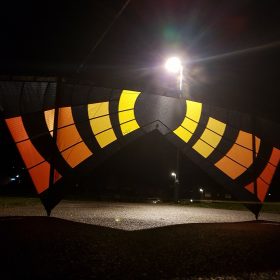 First, the name of this kite (pronounced “Jinn”) is an old world Arabic word for genie, but a much older, darker genus.
First, the name of this kite (pronounced “Jinn”) is an old world Arabic word for genie, but a much older, darker genus.
Some of the design aspects are conceived from my personal, proprietary experience and I hesitate to detail everything here but the most obvious features include:
- Original “Sync Bridle”, using something more like an active bridle arrangement that shares loading between top and bottom controls to provide much smoother flight with almost no-surge” or “uncontrollable power, this gives it a very stable, flexible engine compared to the traditional static quad bridle arrangement. as well as giving us adjustable top speed and input response with a secondary (core) tuning system built in that balances with our usual adjustments on the handle end.
- Latticed seams in the sail (all Icarex PC-31 Polyester) to provide an extremely durable, low stretch surface and pressure area.
- Streamlined fittings on all parts of the kite to eliminate exposed bungee knots and other places that could cause excess wear or line snags during flight.
- Conscious placement of reinforcements in all areas including the leading edge mesh, vertical spar area of the sail and others to make it more durable and particularly, to help the sail keep its original form as long as possible (stretch, etc).

About how the kite feels in flight.. Only in my own subjective opinion, some traditional quad configurations fly with the top half of the kite loaded, leading and powering heavily with the leading edge and outer wings, pressure loss through the trailing edge and sometimes some of the belly too (we call this center panel deflation)… Then, there is a sense of “optional” brake points of the kite, so I basically feel three points of pressure (top half and bottom corners).
What I enjoy very much is a sense of even pressure across the entire sail and smooth transition between forward / reverse inputs, so it feels more like a computer track ball, with a singular holistic pressure and minimal inadvertent “surges” in any direction. That’s our Djinn, all day long.
There is so much more I could say about about all of this, but I’ll leave your readers to explore specifications and examine the kite for themselves at events in the coming year… There is no substitute for kicking the tires, not everyone likes the same kind of vehicle, and nor should they.
I want to be certain you understand exquisitely – the Djinn was NOT born as a “product”, it was conceived as the answer to every need and problem me and my team pilots have experienced in almost 30 years of extreme flight experience… It was made without cost in mind, though once it was complete we were satisfied with the cost and have made our kites available to the public – its a “cart before horse” or “horse before cart” scenario, but the moral of this story is that we built it with a purpose that transcends business or sales, I am a kite flier first, far above everything else.
You will see this trend continue as we release more designs in the future to fill the slots in our own equipment – dual line, quad line, indoor, outdoor. whatever, we do it all and need kites built to our specifications, THEN they become available for anyone who may find a shared enjoyment with them.
What Is the main difference with other (rather classic) quad line kites like the Revolution?
Though I appreciate the question, respectfully, I’m not in the habit of direct comparison – I’ll leave that to the other pilots worldwide. I often say, “let god and skill sort them out.”
What kind of feedback did you get already from other pilots?
This has been the really fun part, because the feedback has almost mirrored our own findings, in a big way… The two words that keep recurring over and over are “connected” and “smooth”, primarily from the superb sail pressure and speed control offered by the Sync Bridle and other details… While I won’t say the Djinn is a “beginner kite”, it handles both beginner and intermediate pilots very kindly.
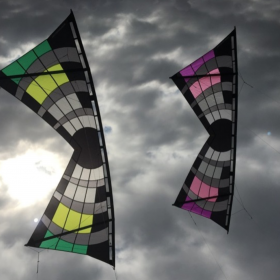 The master pilot side has been slightly more entertaining because of the accumulated style of years flying – new fliers don’t have a style yet and adapt very quickly, whereas some master pilots become very fixed / specialized in their style and require more time to adapt, but we’ve had wonderful feedback from the masters who have spent time on the Djinn.
The master pilot side has been slightly more entertaining because of the accumulated style of years flying – new fliers don’t have a style yet and adapt very quickly, whereas some master pilots become very fixed / specialized in their style and require more time to adapt, but we’ve had wonderful feedback from the masters who have spent time on the Djinn.
The foundation of course, is that a universally ‘perfect kite” doesn’t exist nor will it ever, because kiting is a fully subjective experience… Even now when I do my workshops and instruction, we simply show pilots how to identify all the differences objectively so they can select the best kite for their style and taste – In fact, I still often direct people to kites from Freilein, Polo. Shook, Phoenix, Revolution. etc, depending on what that person needs (budget, physicality, locale. etc) – I don’t really care what kite someone buys, as long as it is a good one for them and they have a fair opportunity for pilot competence and enjoyment.
Regarding build quality, I’ll simply say that the Djinn has already seen time on fields with German quad builders and we’ve received really excellent reviews – and we know, I think most will agree that the German sense of quality / detail Is quite famous, so we take this as a very fine compliment.
Can you also add some pictures of the bag, the kite, some details?
Is there also a UL, STD, VTD? What colors are possible to choose?
Currently we offer three models… Djinn ST (standard full sail), Djinn MV (mid-vent) and Djinn VT (full vent) but are currently prototyping the Djinn XT (extra vent) and HV (hardcore vent) which we hope to release later this year, and we are also working on the “Djinndoor” design for indoor or 0-2 mph outdoor use.
My pilots don’t usually use “SUL” quad kites outdoors, because we are unusually aggressive and dynamic – using athletic movement and a key amount of weight (inertia) to do what we do but the Djinndoor should cover that range nicely.
I think most pilots will find a very, very nice overlap In wind range between the various models.
Colors are all shown on the website but our standard Djinn options are hot, cool, green and purple fades, plus totally custom options are also available for a fee using the colorizer.
Any other video / picture we can add?
There is already a lot online but here are some of my favorite Djinn videos:
Djinn Release
Djinn in Japan
Djinn the Splash Zone
Cordially yours,
John Barresi pour Addict Kite


